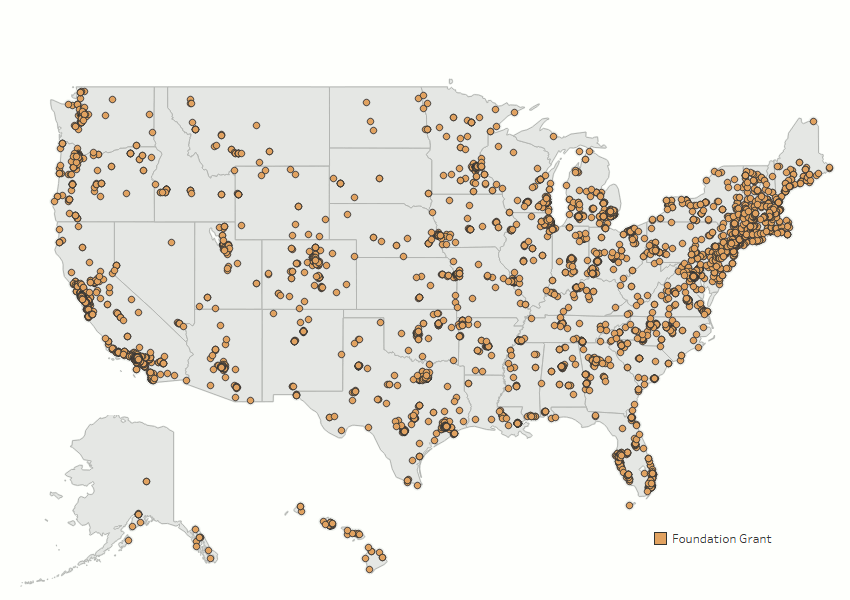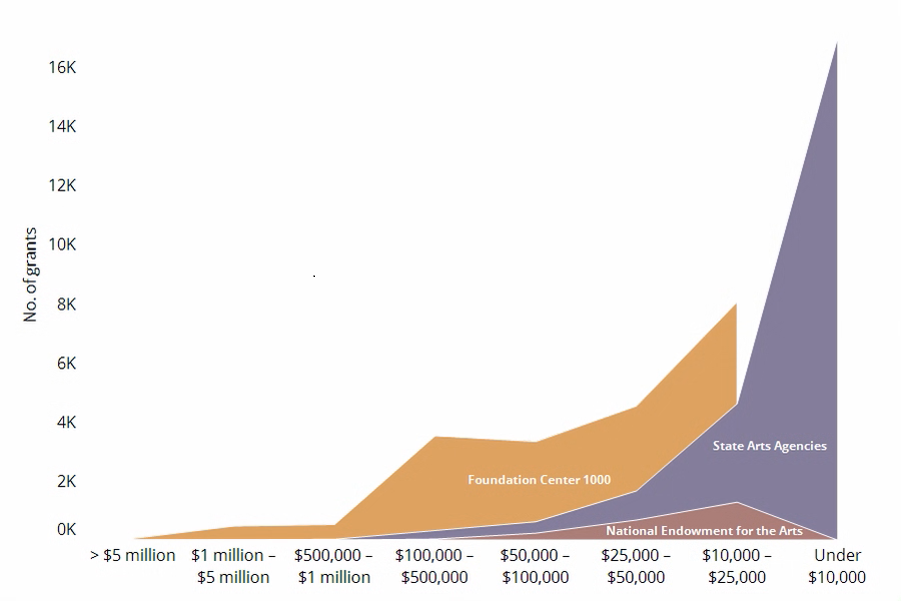The cultural ecosystem requires both public and private support to thrive.

The cultural ecosystem requires both public and private support to thrive.

Mapping the contributions of both the private- and public-sector investments in arts and culture show how they work together to foster American creativity.

Private funders contribute the largest amount of dollars to cultural institutions in the United States.

State and federal arts funders distribute more awards. They ensure access for rural areas and underserved communities, including many in which foundations are not present.

Every state arts agency is supported by federal dollars from the National Endowment for the Arts. This partnership allows public dollars to reach more communities across the country.
 Sources: NASAA, State Arts Agency Final Descriptive Reports, FY2012; National Endowment for the Arts direct grants, 2012; The Foundation Center, 2012, based on all grants of $10,000 or more awarded by the FC 1000, a set of 1,000 of the largest U.S. foundations by giving.
Sources: NASAA, State Arts Agency Final Descriptive Reports, FY2012; National Endowment for the Arts direct grants, 2012; The Foundation Center, 2012, based on all grants of $10,000 or more awarded by the FC 1000, a set of 1,000 of the largest U.S. foundations by giving.
Fourteen percent of the U.S. population resides in rural areas, yet a U.S. Department of Agriculture analysis found that only 5.5% of large foundations’ domestic grant dollars went to rural areas.
In comparison, 14% of both National Endowment for the Arts (NEA) and state arts agency grant dollars were awarded to rural communities.

Note: Rural is defined as counties outside of any metropolitan statistical areas.

Source: GIA [Grantmakers in the Arts] Reader, Vol. 30, No. 1 (Winter 2019); Foundation Center, 2016, excludes grants of less than $10,000; National Endowment for the Arts arts.gov grants search, FY2018, excludes partnership awards to state arts agencies and regional arts organizations; state arts agency Final Descriptive Reports, FY2018.
The median state arts agency grant amount is $5,000, allowing broad distribution of funds to many small organizations.
The median grant size for foundations is more than five times larger: $25,000. Among the foundations tracked longitudinally by the Foundation Center, grants of $500,000 or more accounted for 58% of all their arts funding.
A survey of foundations following the Great Recession found that 57% had not changed their grant making in response to public arts funding declines. As recently as March 2017, a leading foundation stated that it would not be able to compensate for cuts to public support for the arts.
Learn More |
| Browse these resources NASAA produced in cooperation with private-sector partners.
Public Funding for the Arts, 2017, GIA Reader, Vol. 29, No. 1, (Winter 2018). Arts Funding at Twenty-Five, GIA Reader, Vol. 29, No. 1 (Winter 2018). Better Together: Public and Private Funding for the Arts, The Andrew W. Mellon Foundation, June 2017. |
U.S. Department of Agriculture Economic Research Service, Foundation Giving to Rural Areas in the United States Is Disproportionately Low, 2015.
National Assembly of State Arts Agencies, Support for Arts in Rural Communities, 2020.
National Endowment for the Arts, Agency Financial Report Fiscal Year 2018.
Reina Mukai, Foundation Grants to Arts and Culture, 2016: A One-Year Snapshot, GIA Reader, Vol. 30, No. 1 (Winter 2019), p. 2.
Analysis of FY2018 National Endowment for the Arts direct grant awards and state arts agency Final Descriptive Report data for 2018.
Alexis Frasz and Holly Sidford, Helicon Collaborative, How Are Private Funders Responding to Cuts in Public Funding? GIA Reader, Vol. 22, No. 3 (Fall 2011), p. 15.
The Andrew W. Mellon Foundation, Why We Need the NEA and the NEH, 2017.